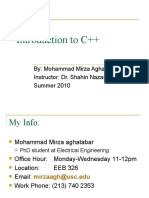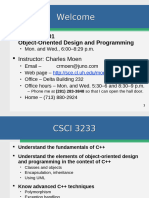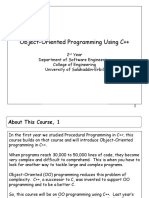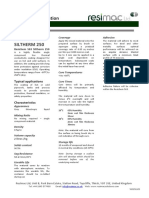Lab 01
Uploaded by
aimenzahid600Lab 01
Uploaded by
aimenzahid600CC-211L
Object Oriented Programming
Laboratory 01
Introduction to C++ and OOP
Version: 1.0.0
Release Date: 12-01-2023
Department of Information Technology
University of the Punjab
Lahore, Pakistan
CC-211L Object Oriented Programming FALL 2022
Contents:
• Learning Objectives
• Required Resources
• General Instructions
• Background and Overview
o Strings C++
o Class
o Object
o Member Function
• Activities
o Pre-Lab Activity
▪ Printing a Line of Text
▪ #include preprocessor directive
▪ Reading an integer from user
▪ Task 01: First C++ Program
▪ Task 02: Middle Number
o In-Lab Activity
▪ Strings in C++
– Strings as Variables
– Input/Output with Strings
– String Operators
– String Processing
o length() and size() function
o at(index)
▪ Object Orientation in C++
– Class
– Declaring Objects of Class
– Accessing Data Members
▪ Task 01: Iterate Strings
▪ Task 02: Palindrome
▪ Task 03: Geometry
▪ Task 04: Find and Correct errors
o Post-Lab Activity
▪ Class Methods
▪ Task 01: Cars
• Submissions
• Evaluations Metric
• References and Additional Material
• Lab Time and Activity Simulation Log
Laboratory 01 – Introduction to C++ and OOP Page 2 of 19
CC-211L Object Oriented Programming FALL 2022
Learning Objectives:
• New Concepts of C++
• Introduction to OOP
Resources Required:
• Desktop Computer or Laptop
• Microsoft ® Visual Studio 2022
General Instructions:
• In this Lab, you are NOT allowed to discuss your solution with your colleagues, even not
allowed to ask how is s/he doing, this may result in negative marking. You can ONLY discuss
with your Teaching Assistants (TAs) or Lab Instructor.
• Your TAs will be available in the Lab for your help. Alternatively, you can send your queries
via email to one of the followings.
Teachers:
Course Instructor Prof. Dr. Syed Waqar ul Qounain swjaffry@pucit.edu.pk
Saad Rahman bsef19m021@pucit.edu.pk
Teacher Assistants
Zain Ali Shan bcsf19a022@pucit.edu.pk
Laboratory 01 – Introduction to C++ and OOP Page 3 of 19
CC-211L Object Oriented Programming FALL 2022
Background and Overview:
Strings C++:
A string in C++ is a type of object representing a collection (or sequence) of different characters. Strings
in C++ are a part of the standard string class (std::string). The string class stores the characters of a
string as a collection of bytes in contiguous memory locations.
Class:
The notion of class was invented by an Englishman to keep the general population happy. It derives
from the theory that people who knew their place and function in society would be much more secure
and comfortable in life than those who did not. The famous Dane, Bjarne Stroustrup, who invented
C++, undoubtedly acquired a deep knowledge of class concepts while at Cambridge University in
England, and appropriated the idea very successfully for use in his new language.
A class is a data type that you define. It can contain data elements, which can either be variables of the
basic types in C++ or other user-defined types. The data elements of a class may be single data elements,
arrays, pointers, arrays of pointers of almost any kind or objects of other classes, so you have a lot of
flexibility in what you can include in your data type. A class can also contain functions which operate
on objects of the class by accessing the data elements that they include.
Object:
When you define a class, you define a blueprint for a data type. This doesn’t actually define any data,
but it does define what the class name means, that is, what an object of the class will consist of and
what operations can be performed on such an object. It’s much the same as if you wrote a description
of the basic type double. This wouldn’t be an actual variable of type double, but a definition of how it’s
made up and how it operates.
Member Function:
The data and functions within a class are called members of the class. Funnily enough, the members of
a class that are data items are called data members and the members that are functions are called function
members or member functions.
Laboratory 01 – Introduction to C++ and OOP Page 4 of 19
CC-211L Object Oriented Programming FALL 2022
Activities:
Pre-Lab Activities:
Printing a Line of Text:
Following program is used to print a line in C++.
Fig 01. (Printing a Line of Text)
The output of the above program is:
Fig 02. (Printing a Line of Text)
#include Preprocessor directive:
#include <iostream> is a preprocessing directive, which is a message to the C++ preprocessor. Lines
that begin with # are processed by the preprocessor before the program is compiled. This line notifies
the preprocessor to include in the program the contents of the input/output stream header. This header
is a file containing information the compiler uses when compiling any program that outputs data to the
screen or inputs data from the keyboard using C++’s stream input/output.
The std namespace:
The std namespace is required when we use names that we’ve brought into the program by the
preprocessing directive #include. The notation specifies that we are using a name, in this case cout, that
belongs to namespace std. The names cin (the standard input stream) and cerr (the standard error stream)
also belong to namespace std.
The Stream Insertion Operator:
In the context of an output statement, the << operator is referred to as the stream insertion operator.
When this program executes, the value to the operator’s right, the right operand, is inserted in the output
stream.
Reading an integer from user:
Following program is used to print a line in C++.
Fig 03. (Reading an Integer)
Laboratory 01 – Introduction to C++ and OOP Page 5 of 19
CC-211L Object Oriented Programming FALL 2022
The output of the above program is:
Fig 04. (Reading an Integer)
Laboratory 01 – Introduction to C++ and OOP Page 6 of 19
CC-211L Object Oriented Programming FALL 2022
Task 01: First C++ Program [Estimated 10 minutes / 10 marks]
Write a C++ program which:
• Displays “This is my first C++ program” on the Console
Task 02: Middle Number [Estimated 10 minutes / 10 marks]
Write a C++ program which:
• Declares three integers
• Read the integers from the user
• Displays the integer which is neither the smallest nor the largest among the three on the Console
Note: if statement is same as used in C language.
Input Output
234 Middle number is: 3
2 5 -1 Middle number is: 2
Laboratory 01 – Introduction to C++ and OOP Page 7 of 19
CC-211L Object Oriented Programming FALL 2022
In-Lab Activities:
Strings in C++:
Strings as Variables:
To create a variable of type string, simply:
“string yourName;” Assignment, is the same:
“yourName = “Saad”;”
Or like before, we could always combine the two with an initialization:
“string ˘ yourName = “Saad”;”
Input/Output with Strings:
I/O with string is shown in the code below:
Fig 05. (Strings I/O)
The output of the above program is:
Fig 06. (Strings I/O)
The code above only input characters before first space character because the space characters are
termination for cin as shown in figure below:
Fig 07. (Strings I/O)
To read a complete line “getline()” function is used with a preprocessor directive “#include
<string>”.
Laboratory 01 – Introduction to C++ and OOP Page 8 of 19
CC-211L Object Oriented Programming FALL 2022
Fig 08. (Strings I/O)
The output of the above program is:
Fig 09. (Strings I/O)
String Operators:
Assignment:
Assignment (=): As used before, assign a string to a variable of type string.
string Name = “Deitel”;
string anotherName = Name;
Both now hold “Deitel”.
Concatenation:
“+” sign is used to put the string at the end of the other.
Fig 10. (String Concatenation)
The output of the above code is:
Fig 11. (String Concatenation)
String Processing:
The string library offers many useful string processing methods.
length() and size():
This method returns the integer length of the string. The length() and size() are the same.
Laboratory 01 – Introduction to C++ and OOP Page 9 of 19
CC-211L Object Oriented Programming FALL 2022
Fig 12. (length() and size() function)
The output of the above program is:
Fig 13. (length() and size() function)
at(index):
This method returns the character at the specified index. Indices start from 0.
Fig 14. (String at())
The output of the above program is:
Fig 15. (String at())
Following is the alternate of at():
Fig 16. (String at() alternate)
Laboratory 01 – Introduction to C++ and OOP Page 10 of 19
CC-211L Object Oriented Programming FALL 2022
Object Orientation in C++:
Class:
A class is a data type that you define. It can contain data elements, which can either be variables of
the basic types in C++ or other user-defined types. The data elements of a class may be single data
elements, arrays, pointers, arrays of pointers of almost any kind or objects of other classes, so you
have a lot of flexibility in what you can include in your data type. A class can also contain functions
which operate on objects of the class by accessing the data elements that they include. So, a class
combines both the definition of the elementary data that makes up an object and the means of
manipulating the data belonging to individual instances of the class.
Let’s create a class of boxes, we will define Box datatype using the keyword class as follows:
Fig 17. (Class)
The name that we’ve given to our class appears following the keyword and the three data members
are defined between the curly braces. The data members are defined for the class using the declaration
statements that we already know and the whole class definition is terminated with a semicolon. The
names of all the members of a class are local to a class. You can therefore use the same names
elsewhere in a program without causing any problems.
Declaring Objects of Class:
We declare objects of class with following statements:
Box box1;
Box box2;
Both of the objects Box1 and Box2 will, of course, have their own data members. The object name
Box1 embodies the whole object, including its three data members. They are not initialized to
anything, however - the data members of each object will simply contain garbage values.
Accessing Data Members:
The data members of objects of a class can be referred to using the direct member access operator “.”.
So, to set the value of the data member length of the object box2 to, say, 10.0, we could write this
assignment statement:
box2.height = 18.0; // Setting the value of a data member.
Following code demonstrates the creation of objects and accessing the data members:
Laboratory 01 – Introduction to C++ and OOP Page 11 of 19
CC-211L Object Oriented Programming FALL 2022
Fig 17. (Class)
The output of the above program is:
Fig 18. (Class)
Laboratory 01 – Introduction to C++ and OOP Page 12 of 19
CC-211L Object Oriented Programming FALL 2022
Task 01: Iterate String [30 minutes / 30 marks]
Write a C++ program that:
• Inputs a string from user
• Count the number of words and spaces in the strings
• Display the count on Console
Input Output
Words: 4
This is a string.
Spaces: 3
Words: 1
String
Spaces: 0
Task 02: Palindrome [30 minutes / 30 marks ]
Create a C++ program that
• Inputs a string from user
• Check if string is Palindrome or not
• Display the result on the Console
Input Output
101 Palindrome
100 Not a Palindrome
1 Palindrome
Task 03: Geometry [20 minutes / 30 marks]
Create a C++ Program that:
• Creates a Class Geometry with data members
o Length
o Width
• Create an object of above Class
• Ask user to Input the Length and Width
• Check if length and width are equal
• Display “Square” on the Console if they are equal otherwise display “Rectangle”
Input Output
Length: 10 Square
Width: 10
Length:10 Rectangle
Width: 5
Laboratory 01 – Introduction to C++ and OOP Page 13 of 19
CC-211L Object Oriented Programming FALL 2022
Task 04: Find and Correct the error [20 minutes / 20 marks]
Find and correct the errors from the following code:
Fig 19. (In-Lab Task 04)
Laboratory 01 – Introduction to C++ and OOP Page 14 of 19
CC-211L Object Oriented Programming FALL 2022
Post-Lab Activities:
Class Methods:
Methods are functions that belongs to a Class. They can be defined inside and outside of a Class.
Following code shows a method defined inside a Class:
Fig 20. (Class Methods)
Following code shows a method defined outside a Class:
Fig 21. (Class Methods)
The scope resolution operator is used to show the relationship of the function with the particular Class.
Laboratory 01 – Introduction to C++ and OOP Page 15 of 19
CC-211L Object Oriented Programming FALL 2022
The output for both of the above codes is same:
Fig 22. (Class Methods)
Laboratory 01 – Introduction to C++ and OOP Page 16 of 19
CC-211L Object Oriented Programming FALL 2022
Task 01: Cars [Estimated 60 minutes / 50 marks]
Part (a):
Create a C++ program that:
• Makes a car Class with data members:
o wheels
o doors
o currentSpeed
• And with Class Methods
o speed (Inside Class)
o break (Outside Class)
• Make two objects in the name of ferrari and mustang.
• Every time when you call speed function currentSpeed is increased by 5 while break function
decrease it by 5.
Laboratory 01 – Introduction to C++ and OOP Page 17 of 19
CC-211L Object Oriented Programming FALL 2022
Submissions:
• For In-Lab Activity:
▪ Save the files on your PC.
▪ TA’s will evaluate the tasks offline.
• For Pre-Lab & Post-Lab Activity:
▪ Submit the .c file on Google Classroom and name it to your roll no.
Evaluations Metric:
• All the lab tasks will be evaluated offline by TA’s
• Division of Pre-Lab marks: [20 marks]
▪ Task 01: First C++ Program [10 marks]
▪ Task 02: Middle Number [10 marks]
• Division of In-Lab marks: [110 marks]
▪ Task 01: Iterate String [30 marks]
▪ Task 02: Palindrome [30 marks]
▪ Task 03: Geometry [30 marks]
▪ Task 04: Find and Correct errors [20 marks]
• Division of Post-Lab marks: [50 marks]
▪ Task 01: Cars [50 marks]
References and Additional Material:
• C++ Strings
https://www.w3schools.com/cpp/cpp_strings.asp
• C++ Input/Output
https://www.w3schools.com/cpp/cpp_user_input.asp
• Classes and Objects
https://www.w3schools.com/cpp/cpp_classes.asp
Laboratory 01 – Introduction to C++ and OOP Page 18 of 19
CC-211L Object Oriented Programming FALL 2022
Lab Time Activity Simulation Log:
• Slot – 01 – 00:00 – 00:15: Class Settlement
• Slot – 02 – 00:15 – 00:30: In-Lab Task
• Slot – 03 – 00:30 – 00:45: In-Lab Task
• Slot – 04 – 00:45 – 01:00: In-Lab Task
• Slot – 05 – 01:00 – 01:15: In-Lab Task
• Slot – 06 – 01:15 – 01:30: In-Lab Task
• Slot – 07 – 01:30 – 01:45: In-Lab Task
• Slot – 08 – 01:45 – 02:00: In-Lab Task
• Slot – 09 – 02:00 – 02:15: In-Lab Task
• Slot – 10 – 02:15 – 02:30: In-Lab Task
• Slot – 11 – 02:30 – 02:45: Evaluation of Lab Tasks
• Slot – 12 – 02:45 – 03:00: Discussion on Post-Lab Task
Laboratory 01 – Introduction to C++ and OOP Page 19 of 19
You might also like
- Advanced C++ Interview Questions You'll Most Likely Be AskedFrom EverandAdvanced C++ Interview Questions You'll Most Likely Be AskedNo ratings yet
- Introduction To Developing Web Applications - NetBeans IDE Tutorial PDF100% (1)Introduction To Developing Web Applications - NetBeans IDE Tutorial PDF8 pages
- Kendriya Vidyalaya Sangathan: Study Material (Computer Science) Class-Xii 2014-15No ratings yetKendriya Vidyalaya Sangathan: Study Material (Computer Science) Class-Xii 2014-15177 pages
- Immediate download Solution Manual for Starting Out with C++: Early Objects, 8/E 8th Edition : 013336092X all chapters100% (3)Immediate download Solution Manual for Starting Out with C++: Early Objects, 8/E 8th Edition : 013336092X all chapters54 pages
- C++ Tevhnical Paper Presentation With Some Changes100% (1)C++ Tevhnical Paper Presentation With Some Changes117 pages
- Introduction To C++: By: Mohammad Mirza Aghatabar Instructor: Dr. Shahin Nazarian Summer 2010No ratings yetIntroduction To C++: By: Mohammad Mirza Aghatabar Instructor: Dr. Shahin Nazarian Summer 201072 pages
- 22CS101-Problem Solving Using C++ Unit IINo ratings yet22CS101-Problem Solving Using C++ Unit II87 pages
- Introduction To Programming For Games DevelopmentNo ratings yetIntroduction To Programming For Games Development30 pages
- Object Oriented Programming and Desigbn Question Bank Unit - I Object and ClassesNo ratings yetObject Oriented Programming and Desigbn Question Bank Unit - I Object and Classes9 pages
- Solution Manual for Starting Out with C++: Early Objects, 8/E 8th Edition : 013336092X - Latest Version Can Be Downloaded Immediately100% (5)Solution Manual for Starting Out with C++: Early Objects, 8/E 8th Edition : 013336092X - Latest Version Can Be Downloaded Immediately43 pages
- EMV of ALTERNATIVES - Final RequirementNo ratings yetEMV of ALTERNATIVES - Final Requirement28 pages
- 32.power System Study-Sc, RC & Dynamic Testing100% (2)32.power System Study-Sc, RC & Dynamic Testing136 pages
- Design Calculations For Pressure VesselsNo ratings yetDesign Calculations For Pressure Vessels54 pages
- Abacus Academy of Kerala: Application FormNo ratings yetAbacus Academy of Kerala: Application Form1 page
- Rean Water Tech Pvt. LTD.: Isolated Footing Design100% (1)Rean Water Tech Pvt. LTD.: Isolated Footing Design5 pages
- Atomization For Spray Drying Unanswered Questions and Industrial NeedsNo ratings yetAtomization For Spray Drying Unanswered Questions and Industrial Needs6 pages
- Image Compression: Mohamed N. Ahmed, PH.DNo ratings yetImage Compression: Mohamed N. Ahmed, PH.D67 pages
- PDF From Finite Sample to Asymptotic Methods in Statistics 1st Edition Pranab K. Sen download100% (1)PDF From Finite Sample to Asymptotic Methods in Statistics 1st Edition Pranab K. Sen download77 pages
- Advanced C++ Interview Questions You'll Most Likely Be AskedFrom EverandAdvanced C++ Interview Questions You'll Most Likely Be Asked
- Introduction To Developing Web Applications - NetBeans IDE Tutorial PDFIntroduction To Developing Web Applications - NetBeans IDE Tutorial PDF
- Kendriya Vidyalaya Sangathan: Study Material (Computer Science) Class-Xii 2014-15Kendriya Vidyalaya Sangathan: Study Material (Computer Science) Class-Xii 2014-15
- Immediate download Solution Manual for Starting Out with C++: Early Objects, 8/E 8th Edition : 013336092X all chaptersImmediate download Solution Manual for Starting Out with C++: Early Objects, 8/E 8th Edition : 013336092X all chapters
- C++ Tevhnical Paper Presentation With Some ChangesC++ Tevhnical Paper Presentation With Some Changes
- Introduction To C++: By: Mohammad Mirza Aghatabar Instructor: Dr. Shahin Nazarian Summer 2010Introduction To C++: By: Mohammad Mirza Aghatabar Instructor: Dr. Shahin Nazarian Summer 2010
- Object Oriented Programming and Desigbn Question Bank Unit - I Object and ClassesObject Oriented Programming and Desigbn Question Bank Unit - I Object and Classes
- Solution Manual for Starting Out with C++: Early Objects, 8/E 8th Edition : 013336092X - Latest Version Can Be Downloaded ImmediatelySolution Manual for Starting Out with C++: Early Objects, 8/E 8th Edition : 013336092X - Latest Version Can Be Downloaded Immediately
- Rean Water Tech Pvt. LTD.: Isolated Footing DesignRean Water Tech Pvt. LTD.: Isolated Footing Design
- Atomization For Spray Drying Unanswered Questions and Industrial NeedsAtomization For Spray Drying Unanswered Questions and Industrial Needs
- PDF From Finite Sample to Asymptotic Methods in Statistics 1st Edition Pranab K. Sen downloadPDF From Finite Sample to Asymptotic Methods in Statistics 1st Edition Pranab K. Sen download

























































































